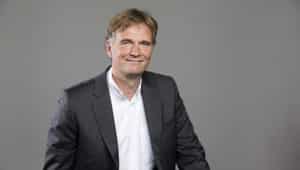Stockholm (HedgeNordic) – One of the most widely recognized pearls of wisdom of Warren Buffett goes along the lines of “Rule number one: Don’t lose money. Rule number two: don’t forget rule number one.” A three-member team out of Stockholm comprised of Thomas Pohjanen (pictured), Björn Suurwee and Marek Ozana too believe that avoiding a loss should be the primary goal of their fixed-income macro hedge fund Excalibur.
“A good risk-adjusted return relies on a proved ability not to lose too much when you are wrong.”

“A good risk-adjusted return relies on a proved ability not to lose too much when you are wrong,” says Pohjanen, who founded one of Sweden’s oldest hedge funds alongside Björn Suurwee in 2001. Excalibur has delivered a net-of-fees annualized return of 4.6 percent since inception, well within its long-term target return band of four to five percent a year. The fixed-income macro fund experienced only two down years in its almost 20-year history, with both of these annual losses running within a range between a low one percent and two percent. “These figures tell you more about how we run our risk book than words can say,” points out Pohjanen. “The powerful effect of compounded interest adds up to 140 percent performance since inception.”
The Strategy in Focus
“Excalibur is active in the field of fixed income in three main markets: Sweden, the Eurozone and the United States,” Pohjanen tells HedgeNordic. However, “the strategies that we employ are not exclusively fixed income, they can also entail positions that are more FX-related,” he continues. “The majority of the type of themes and plays that you would find in Excalibur’s portfolio and could have found over the now almost 20 years have been in those two fields,” says Pohjanen. “No equities, no raw materials, metals or anything else.”

To achieve Excalibur’s long-term return objective, Pohjanen and his team look for major macroeconomic themes shaping up in fixed-income markets. “We tend to be rather conservative in terms of having too many themes on,” says Pohjanen. “Over the years I have seen correlations move to one very quickly in stressed periods, so I am not a fan of putting a large number of trades that statistically look okay in calm weather,” he continues. For that reason, Excalibur’s portfolio usually reflects between five to seven themes at any given point in time, with every theme composed of four to five trades.
“We tend to be rather conservative in terms of having too many themes on. Over the years I have seen correlations move to one very quickly in stressed periods.”
“The themes would typically be built around the shape of the yield curve, outright level of yields, and spreads between instruments,” explains Pohjanen. These are relative value and absolute value plays “one would normally recognize in any fixed-income portfolio that is absolute return.” Pohjanen goes on to emphasize that the team at Excalibur “utilize the full range of fixed-income financial instruments, including futures, cash bonds, swaps, interest rate options or currency options.”
“The themes would typically be built around the shape of the yield curve, outright level of yields, and spreads between instruments.”
The three-member team running Excalibur use “many different venues” to search for these five to seven themes. “First and foremost, all the things and information we take in as managers that form the basis of our discussions,” Pohjanen elaborates on the team’s information processing approach. “We decide upon what has the potential to become a theme and what we should move forward with and analyze in further depth,” he continues. “That type of intake ranges from things that would consider any economically-interested person, all the media around us, all the initiated magazines, newspapers, digital as well as printed,” Pohjanen lists some of their information sources. The team also use purchased independent research, research from banks, and other sources of macro-based research.
Always Delivering in Stressed Periods
The measures that governments and central banks around the world have taken in response to the coronavirus pandemic have created a fertile environment for the fixed-income macro hedge fund run by Pohjanen and his team. Excalibur gained 9.4 percent over the rolling 12-month period through the end of October and 8.0 percent year-to-date. “This particular year, with the stress in the market place and volatility that followed up on the unfortunate outbreak in Wuhan, things, of course, moved very quickly,” says Pohjanen. “It seems to me that stressed market situations tend to create market situations where prices are moving out of the realm of economically-motivated,” which can provide attractive risk-reward opportunities for funds such as Excalibur.
“It seems to me that stressed market situations tend to create market situations where prices are moving out of the realm of economically-motivated.”
The themes and plays that contributed most to Excalibur’s 2020 performance have revolved around the policy responses to the coronavirus pandemic. The strong performance stems from “the expectations that we would get a significant policy response when we and others in the market came to realize the seriousness of this situation,” explains Pohjanen.
One of the themes focused on central bank activity in Europe and Sweden. “In Europe, the Riksbank and the ECB were at a policy level where a change in the level of interest rates, the repo rate, could not really do much,” says Pohjanen. “Very early, the conclusion by our team here in Stockholm was that the mainstay of the policy support would come from QE. We expected heavy support by the ECB in different countries involved in the Eurozone,” he continues. “As that expectation was given a high level of confidence in our discussion, we proceeded to construct trading strategies or themes.” The team at Excalibur, therefore, was more bullish on peripheral eurozone debt than the debt in the core economies.
“Another theme closer to home involved some of the high-quality bonds that we trade and have traded over the years in the Swedish market, non-government bonds but still high quality in terms of credit risk and liquidity, which were trading at attractive levels in our view,” says Pohjanen. “We also expected the Riksbank to be very aggressive and that, of course, would lead to them increasing purchases and starting purchases of bonds that they had purchased before, and so they did.”
“It seems that one of the advantages of our style is that the experience of the team leads us to be able to quickly process incoming data, propose strategies, and enact them in our portfolios when volatility strikes and the level of stress hits the market.”
Looking back at Excalibur’s track record, one could easily notice that the fund is performing strongly in highly turbulent market environments such as the financial crisis of 2007-2009, the European sovereign debt crisis that followed and this year’s coronavirus-induced crisis. “It seems that one of the advantages of our style is that the experience of the team leads us to be able to quickly process incoming data, propose strategies, and enact them in our portfolios when volatility strikes and the level of stress hits the market,” highlights Pohjanen. “That seems to be an ingredient that has been with us.”
Pictures by Rickard Kilström.

